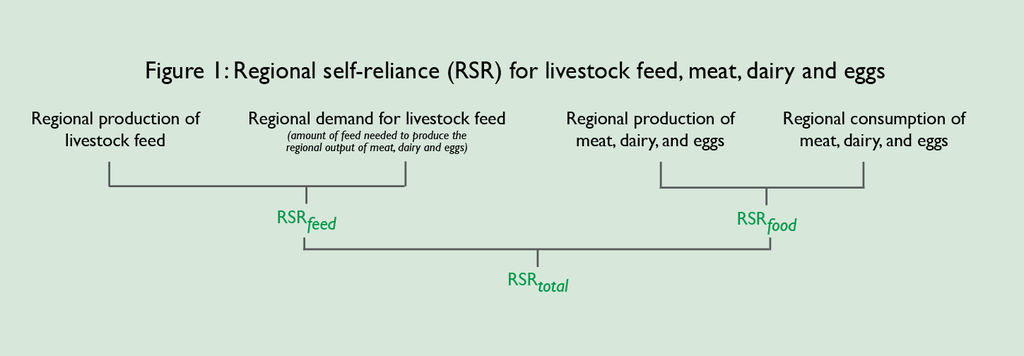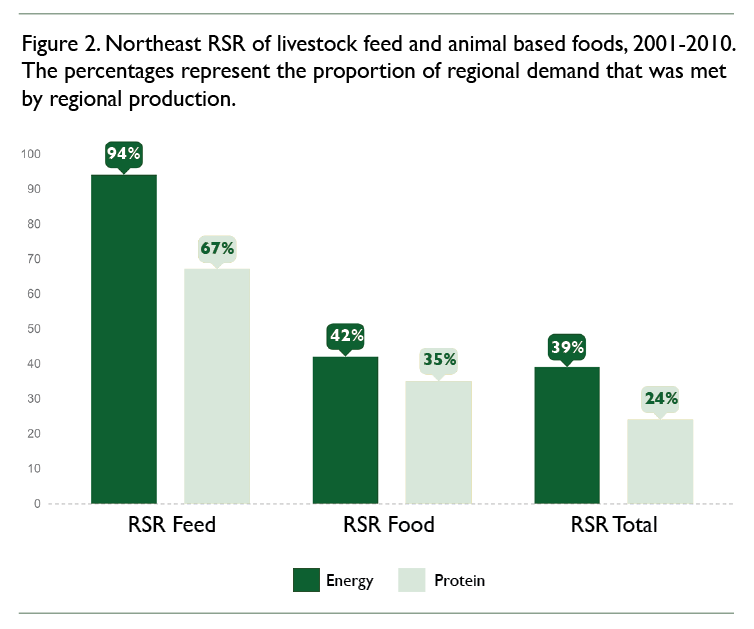A summary of “Regional self-reliance for livestock feed, meat, dairy and eggs in the Northeast USA,” by Zach Conrad*, Nicole E. Tichenor*, Christian J. Peters*, and Timothy S. Griffin*. Published in Renewable Agriculture and Food Systems, Volume 32, Issue 2, April 2017, pp. 145-156.
Key Takeaways
- The Northeast region imported more livestock feed, meat, dairy, and eggs than it produced from 2001-2010 in order to meet regional demand for these products.
- Livestock feed production in the region accounted for 39% and 24% of energy and protein, respectively, consumed via meat, dairy, and eggs in the region.
- Most (80%) of the land used for livestock feed was located in just three states: Pennsylvania, New York, and West Virginia.
* Friedman School of Nutrition Science and Policy, Tufts University
The production of food-producing animals in the U.S. is largely separate from the production of the grains and forages (hay, pasture, etc.) they eat. The grain crops are primarily produced in Midwestern states, often referred to as the Corn Belt. While this geographic concentration has resulted in certain efficiencies, it also poses risks. For example, nationwide price increases for meat and dairy may result from any number of disturbances in key production regions, including disease outbreaks or extreme weather events. Concentrated production also can create pollution problems stemming from fertilizer, manure, and other sources. Given these risks and growing consumer demand for locally and regionally sourced foods, would it increase food system resilience to relocate animal feed production over a greater geographical area? To answer this question, it is first necessary to understand how well regions are currently meeting their own demand for these products, and in turn, the degree to which regional livestock operations are meeting regional demand for animal-based foods including meat, dairy, and eggs.
Objectives
This study built upon the research team's earlier work that examined how well the Northeast U.S. region can satisfy the food needs of its population, a concept known as Regional Self-Reliance (RSR). In the earlier study, the researchers established that from 2001 to 2010, 56 percent of the region's farmland was devoted to the production of animal feed, totaling more than 15 million acres. As a follow-up, the researchers wanted to identify the types and amounts of feed produced on this acreage and the extent to which this production meets the needs of livestock operations in the Northeast. They also wanted to estimate the degree to which this level of feed and livestock production meets the demand for meat, dairy, and eggs in the region.
The Study
Calculating the regional self-reliance for animal feed
In order to understand how well regional production meets the regional demand for animal feeds, the researchers first had to quantify this demand, which was a two-part process. First, they calculated the general feed requirements of various types of livestock on a per animal basis, which they then multiplied by the inventory of animals associated with the amount of meat, dairy, and eggs produced in the region.
Assessing the feed requirements for livestock is not a straightforward calculation, due to inherent complexities of animal production systems. For example, in order to produce beef continuously, farmers maintain whole mixed-age herds of male and female animals that need to be fed year-round, even after calves may be shipped off to be fattened elsewhere. Furthermore, some of the herd's breeding animals will be removed from the herd each year and become beef as well. Dairy systems are similarly complex, and connect to the beef supply. On any given dairy farm, for instance, some calves will be maintained for the breeding herd, some may be funneled into the veal supply chain, and some may be shipped to one or more feeding operations and raised to a mature slaughter age, similar to most beef cattle. Older cows no longer producing milk will also be culled and slaughtered, thus entering the the beef supply. Therefore, in order to estimate how much feed is needed to produce a certain amount of beef or milk, the researchers had to account for how much feed an entire herd of beef cattle or dairy cattle consumes, respectively.
To address these complexities, the researchers developed a computational model developed by research team member Dr. Christian Peters of Tufts University. The model estimates the nutritional needs of each livestock type (beef cattle, dairy cattle, broilers, layers, turkeys, and swine), how these nutritional needs vary across the lifespan, and rates of reproduction and mortality. Using this information, the model computed the total feed requirements for each livestock type, assuming a specific nutrient content of each type's feed ration. Feed requirements were then multiplied by the quantity of meat, dairy, and eggs produced in the region from 2001 to 2010 in order to arrive at the total average annual regional demand for feed.
Next, the researchers compared total regional feed demand to total regional feed production. They had already quantified feed production in their earlier study but only in terms of weight. Livestock feed requirements are measured in terms of nutrients, so they converted their earlier production data into units that relate to the nutrients provided by each feed crop, namely total digestible nutrients (TDN) and crude protein (CP). By comparing the total amount of TDN and CP produced in the region with the amount of TDN and CP required by regional livestock operations, the researchers arrived at an estimate of how self-reliant the region was in meeting demand for these crops during the study period.
 Calculating the regional self-reliance for meat, dairy, and eggs in terms of feed inputs
Calculating the regional self-reliance for meat, dairy, and eggs in terms of feed inputs
The earlier study estimated the amount of meat, dairy, and eggs produced and consumed in the region on an average annual basis from 2001 to 2010. Once again, these data were converted into units that correspond to the nutrients in livestock feed. Data on production and consumption of meat, dairy, and eggs were converted into units of human-edible energy (calories) and human-edible protein, which correspond to TDN and CP, respectively. This calculation provided the total production and consumption of human-edible energy and protein from meat, dairy, and eggs.
Findings
Regional self-reliance for livestock feed
The livestock in the region that were slaughtered for meat or that produced dairy or eggs required feeds and forages containing 19.4 billion kilograms (kg) of TDN and 5.1 billion kg of CP annually during the 2001-2010 study period. Demand varied significantly by animal type, and was greatest for the dairy system, which accounted for 58 percent of TDN and 56 percent of CP demand. Demand was lowest for turkey operations, which accounted for only 2 percent of TDN and 3 percent of CP demand.
This feed/forage demand was not met entirely by regional production. The researchers found that, on average, 18.3 billion kg of TDN and 3.4 billion kg of CP were produced on Northeast farmland annually during the study period, meeting 94 percent of regional demand for TDN and 67 percent of regional demand for CP during the same time period.
Regional self-reliance for meat, dairy, eggs
The earlier study revealed the regional self-reliance for meat, dairy, and eggs in terms of weight. The current study quantified this in terms of nutrients, demonstrating that regional production of meat, dairy, and eggs satisfied 42 percent of the regional demand for human-edible energy and 35 percent of the demand for human-edible protein.

Connecting the RSR for livestock feed to the RSR for meat, dairy, and eggs
In order to understand the degree to which the regional production of animal feed helps to meet the regional demand for meat, dairy, and eggs, the researchers combined the Regional Self-Reliance scores of each. The combined figures indicate that livestock feed production in the region accounted for 39 and 24 percent of the human-edible energy and protein, respectively, consumed via meat, dairy and eggs in the region.
Conclusion
The Northeast region contains only four percent of the nation's cropland, but due to the large share of its acreage devoted to feed and forage production, the region is still able to meet a significant amount of the regional demand for livestock feed and (to a lesser extent) for meat, dairy, and eggs. If the region as a whole wanted to meet even more of its demand for these foods in the future, the Northeast would have to increase agricultural production of animal feeds and meat, dairy, and eggs.


